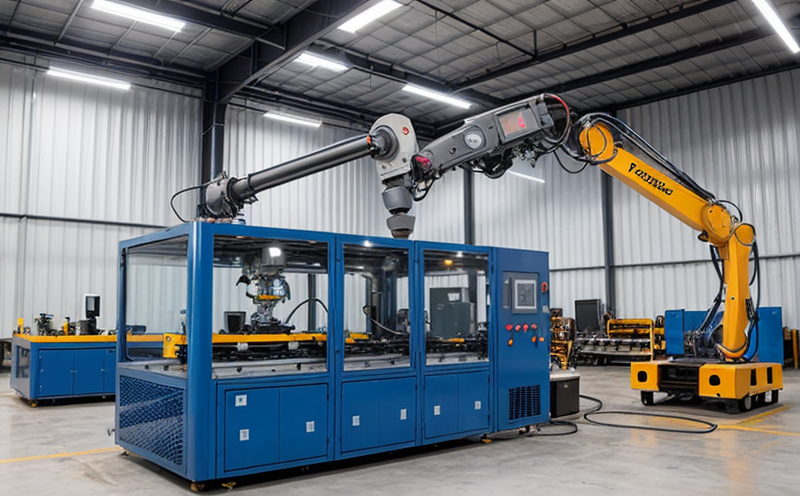ISO 9409 Mechanical Interface Testing of Robot Arms
The ISO 9409 standard is a critical cornerstone in ensuring the mechanical interface compatibility and robustness of robotic arms employed in industrial manufacturing processes. This service focuses on the comprehensive testing methodologies for verifying that robot arms meet stringent international standards, thereby enhancing safety, reliability, and performance in complex manufacturing environments.
Robotics technology has revolutionized industrial manufacturing by automating tasks previously performed manually. As industries diversify into more intricate processes, the mechanical interfaces connecting robotic components become increasingly vital. The ISO 9409 test ensures that these interfaces can withstand the dynamic forces exerted during operation without compromising functionality or safety.
The testing process involves subjecting the robot arm to a series of predefined loads and cycles designed to simulate real-world manufacturing conditions. This includes torque, impact force, vibration, and temperature variations. The goal is to identify potential points of failure early in the development phase, allowing for necessary adjustments before deployment into high-stress environments.
Compliance with ISO 9409 not only ensures that robotic systems meet industry standards but also contributes to improving overall quality control within manufacturing facilities. By adhering to this standard, manufacturers can enhance their reputation by demonstrating a commitment to excellence and safety in product design.
The testing procedure typically begins with an initial inspection of the robot arm’s mechanical components according to ISO 9409 specifications. Following this, the arm undergoes various load tests using specialized fixtures that replicate typical working conditions encountered during assembly or material handling operations. These tests measure displacement, stress distribution, and deformation rates under specified cyclic loads.
Accurate measurement tools such as strain gauges, accelerometers, and displacement sensors play crucial roles in capturing detailed data throughout the testing process. This information is then analyzed to assess compliance with ISO 9409 requirements regarding dimensional tolerances and material properties. Any deviations from these standards would indicate areas requiring improvement.
After completing all prescribed tests, a final inspection confirms whether any corrective actions need implementation before certifying the robot arm as compliant with ISO 9409 guidelines. Once approved, certified documentation will accompany each tested unit, providing assurance to end-users about its reliability and safety performance levels.
In summary, our ISO 9409 mechanical interface testing service offers valuable insights into how your robotic systems perform under rigorous conditions. By leveraging this expertise early in the development cycle, you can identify potential issues before they become costly problems later on.
Applied Standards
| Standard Number | Description |
|---|---|
| ISO 9409-1:2018 | Specification for mechanical interfaces of industrial robots - Part 1: General requirements and definitions. |
| ISO 9409-2:2016 | Specification for mechanical interfaces of industrial robots - Part 2: Test methods for the determination of performance characteristics. |
The above standards provide clear guidelines on how to perform ISO 9409 testing, including specific parameters like load ranges and environmental conditions. These international standards ensure consistency across different manufacturers while promoting innovation through robust testing practices.
Benefits of ISO 9409 Mechanical Interface Testing for Industrial Robotics
Adopting this service brings numerous advantages to industrial robotics and automation systems, enhancing both safety and operational efficiency. Here are some key benefits:
- Enhanced Safety: By identifying potential weaknesses in mechanical interfaces early on, companies can prevent accidents that could result from improper interface design.
- Better Performance: Ensuring compliance with ISO 9409 standards helps optimize the performance of robotic arms by minimizing wear and tear caused by overloading or misalignment issues.
- Increased Reliability: Robust testing reduces downtime associated with unexpected failures, leading to smoother operations throughout production cycles.
- Improved Compliance: Adhering to internationally recognized standards like ISO 9409 strengthens your company’s reputation and builds trust among customers who value quality assurance processes.
In addition to these tangible benefits, adopting ISO 9409 testing also fosters a culture of continuous improvement within organizations, driving innovation in robotics technology. This approach ultimately contributes to creating safer, more efficient workplaces across various sectors.
Use Cases and Application Examples
- Automotive Assembly: Ensuring that robotic arms used in car manufacturing plants can handle heavy loads without sustaining damage during assembly processes.
- Packaging Industries: Verifying the strength of robotic arms employed for palletizing operations to prevent product damage and ensure smooth workflow.
- Electronics Manufacturing: Testing robotic arms involved in delicate tasks such as soldering or component placement to guarantee precision and accuracy.
- Petrochemical Plants: Subjecting robotic arms to high-temperature environments to confirm their ability to function correctly even under extreme conditions.
These examples highlight just a few of the many applications where ISO 9409 mechanical interface testing proves beneficial. Regardless of industry or application, our service ensures that all robotic systems meet stringent quality standards before deployment into critical operations.





